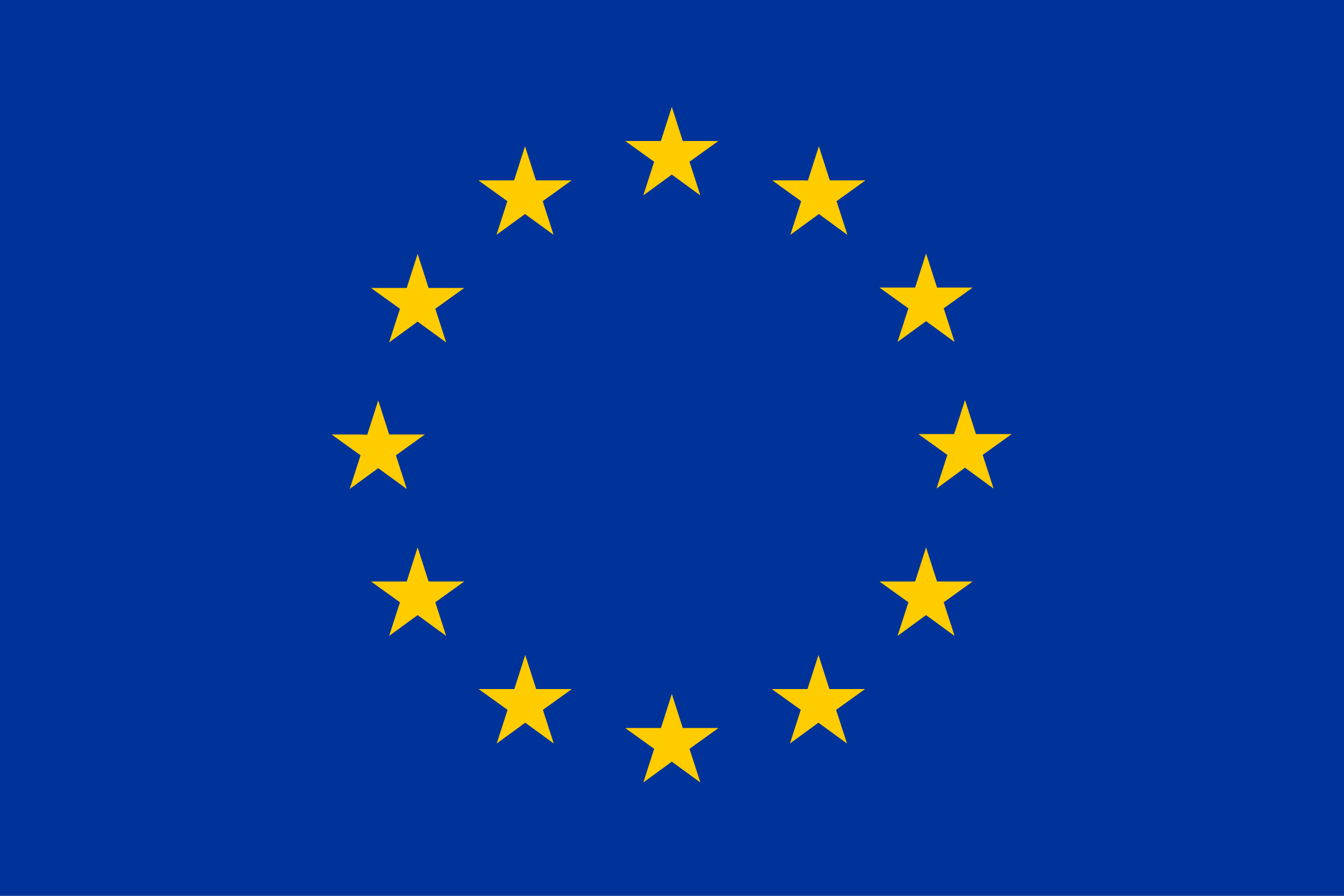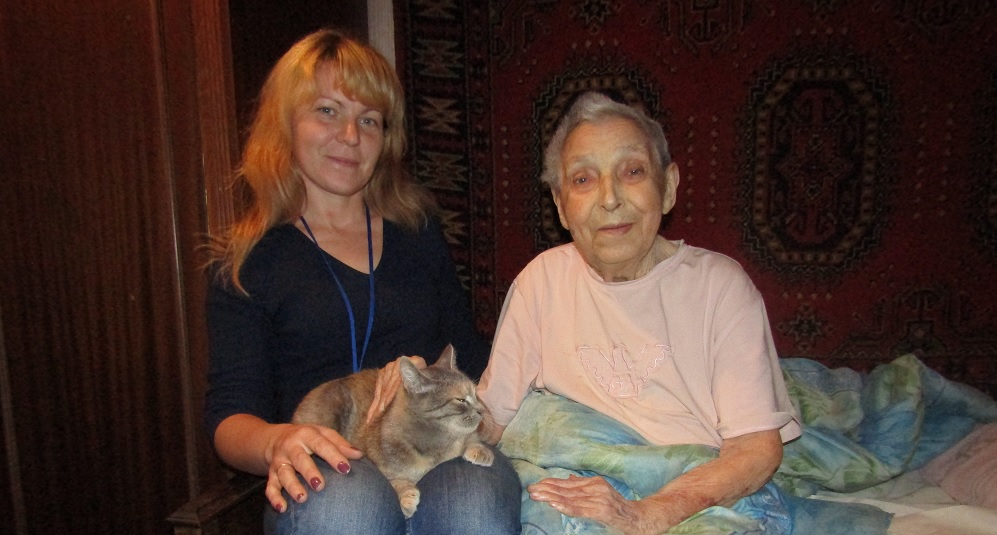
Nadezhda Fedorovna slowly pulls herself up to a sitting position on the bed. She smiles at us warmly and offers both hands in greeting, although her fingers can no longer grip. Yulia, a volunteer with HelpAge International’s emergency protection-based support project in eastern Ukraine, sits beside her on the bed and combs her hair as she tells us about her life. Meanwhile, her constant companion, a small grey cat called Umka, rescued as a kitten, frolics at our feet.
Now 85, Nadezhda had stayed healthy and relatively active until 2016, when an artillery bombardment by separatist militia ripped through the walls of her apartment block, causing head and spinal injuries that have left her partially paralysed and with limited hearing.
Like so many, she and her husband arrived in the 1960s to work at the huge Avdiivka Coke and Chemical Plant that dominates the town. One of the largest such plants in Europe, it used to employ thousands. But with automation, many of the workers were laid off, and then with conflict, the plant is operating at only one-third capacity. This means jobs are now scarce.
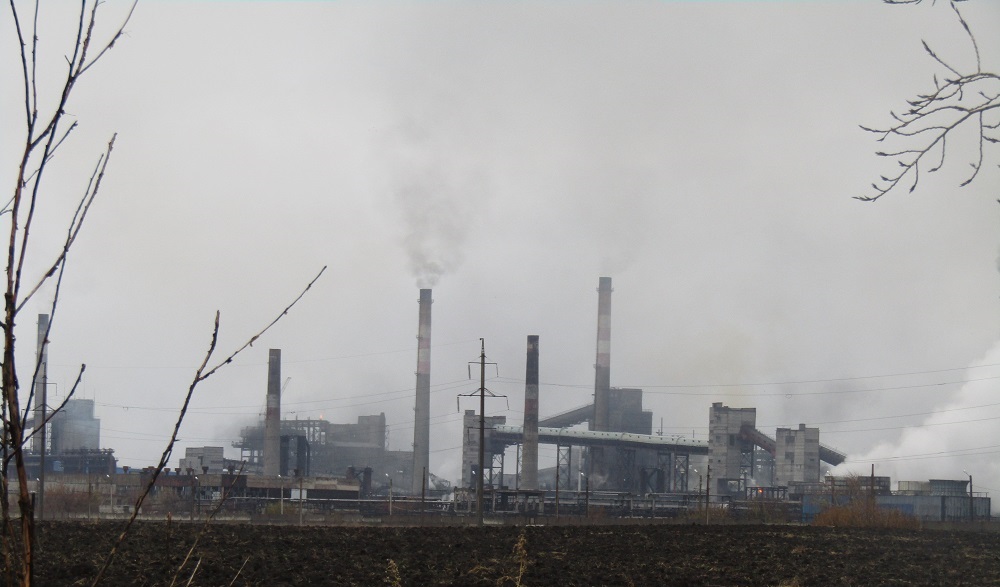
Nadezhda speaks slowly, and tears come to her eyes as she struggles to remember the past. “I was a machinist on a pumping station, but had to stop working after a few years to look after our sons. My husband worked very hard in conditions that were not good for his health. He got a stroke and died right there in the factory… that was in 1983,” she said.
“Then when the fighting started, one of my sons was living in the Donetsk area across the front line, so he cannot visit anymore. The neighbours are helpful and Yulia looks after me so kindly, talking to me, hugging me, and helping me take food and medicine.”
Her other son still lives with her, but he suffered a bad stroke two years ago, and is not able to lift her or help her with her care. She explains how Yulia’s regular visits – three or four days a week – give her a lifeline. As well as providing care and psychological support, Yulia has guided her through the fraught bureaucracy of registering with a family doctor, necessitated by national healthcare reforms that are proving very challenging for most Ukrainians, and especially for many older people living near the contact line.
“I have no more hopes and dreams for myself, but I wish strongly for peace and health for our community and our country,” she said.
Avdiivka’s community safe space
Although this district has not seen heavy fighting or shelling for around 18 months, the conflict has destroyed livelihoods, and its signs are visible everywhere. Murals and graffiti attempt to bring life to damaged and derelict buildings, army checkpoints block the roads, and signs warning of landmines stand ominous guard over fields of stubble and black earth, where no-man’s land is marked by a sallow line of poplars, shivering under autumn rain.
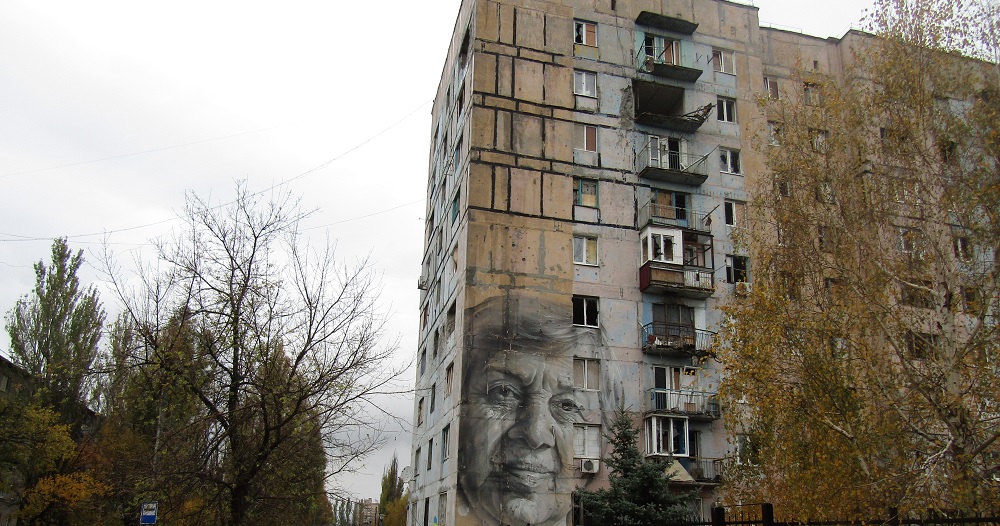
The local nursery school closed when the conflict started. But the public hall on its grounds is now open six days a week as a community safe space, staffed by project assistants and volunteers, and funded by HelpAge’s Ukraine office. We receive a warm welcome in the crowded and cosy room. Around 20 older women, one older man and a very young boy, a grandson, are busy painting pictures of the Eiffel Tower, making ribbon tapestries, drinking cups of tea and coffee, and eating biscuits.
We sit down and chat with them, amid laughter and joking at my broken Russian introductions. They answer questions. Yes, all of them used to work in the factory shoveling and sorting coke – hard manual labour. Some of them have disabilities, but they can still get around and they love coming to the centre to keep active through creative arts and exercise sessions. Most of them are widowed. The children have mostly left, and there is not much work anyway since the factory automated. The roads are bad and most of the shops closed after the shelling started in 2014.
They ask me lots of questions about my family and life in Britain, and we pose together for photos. One woman stands up, clutches her hands to her chest and sings a powerful song to me, and others join in the chorus. It is a wonderful, uplifting moment.
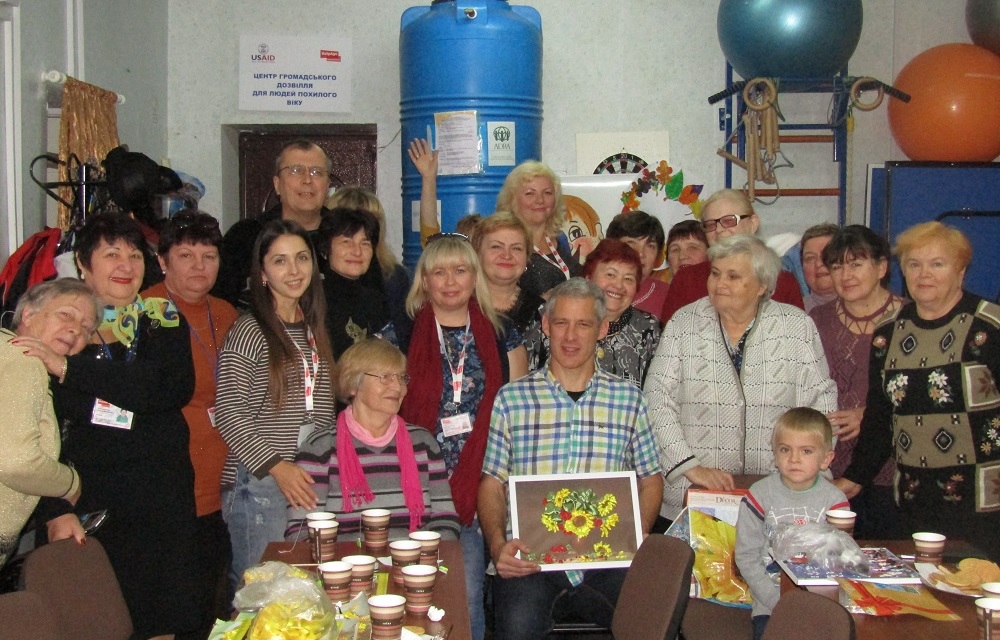
I am told that the community safe space is regularly used by around 300 older people and internally-displaced persons who fled from nearby villages and from across the contact line. The most popular activities are embroidery, drawing, watching movies and playing with the grandchildren. There is a small library to which they all donate books, and the HelpAge staff give them training workshops on caring for themselves and others, and accessing health services in the challenging new medical system, among other things.
It is clearly a thriving, learning and joyful community that benefits its members and the local area greatly. But not everyone can physically walk to get there, and some of the oldest and most vulnerable people – like Nadezhda Fedorovna – need regular visits and home-based care from the volunteers.
Caring for Viktor in his home
Yulia took us on her rounds to meet 81-year-old Viktor Georgievich. Before he turned five, both Viktor’s parents had died in the Second World War, which claimed millions of Ukrainian lives. He survived a hard childhood in an orphanage, and came to Avdiivka to work in the factory and start a family. His wife and their older son died, and 30 years of hard working conditions caused problems with his spine and legs.
He now spends nearly all of the day in bed in his cluttered room in a small apartment with his younger son Alexandre, daughter-in-law Natasha and their two children. The walls and doors are cracked from shelling, and the broken windows only recently replaced after much lobbying of the local authorities.
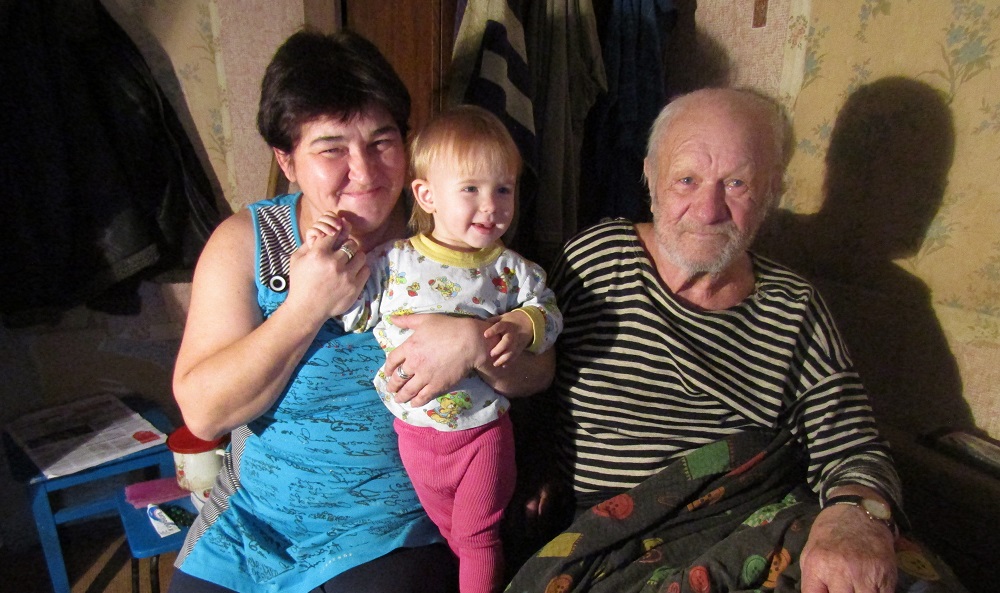
“Thanks to Yulia, I still do get out to sit outside the apartment block and see the neighbours,” Viktor told us. “But it is becoming more painful to walk and I need my stick and someone to help. Yulia also helps me with my physio exercises and other treatment I need. With her visits, and my family around I am never lonely. I love to play with my baby granddaughter and see her smile.
“In 2016 we were all here when the block got hit by shells – they broke the windows and damaged the walls and doors, but thank God none of us was hurt. Life has been hard for the family and the community. The kindergarten closed so Natasha lost her job there and my son only works shifts so is struggling to pay for food and rent. This country has suffered so much and now we need peace – I want my granddaughter to grow up healthy and happy.”
Sustaining safe spaces – what happens now?
On the bumpy drive back to Sloviansk, 100 miles away through the rich but deserted farmland and derelict Soviet-era factories, we talk about community safe spaces and what they mean to the older people trapped near the contact line – those who can’t or won’t leave their homes – as well as to wider communities.
The conflict has ripped apart families and communities, and closed roads and railways to trade and transport. Tens of thousands have fled to nearby cities like Sloviansk, where many large NGOs and HelpAge’s project office are based. Our work is funded by USAID and the EU, but on an unpredictable year-by-year basis.
Since the conflict began in 2014, HelpAge has set up more than 20 community safe spaces, and currently manages 12 in the Donetsk and Luhansk regions, close to the contact line along which the Ukrainian army is engaged in an uneasy stand-off with separatist forces. As well as engaging vulnerable older people, including many with disabilities, in group activities and outreach, the project is tackling isolation, violence and abuse.
The dedicated staff and volunteer teams provide expert training to strengthen the capacity of local peer networks, creating community cohesion and enabling inter-generational support and integration of internally-displaced people into host communities.
Since 2016, HelpAge established and continues to chair the Age and Disability Technical Working Group in Ukraine, which includes other NGOs, local groups and government departments at both national and local levels. This has become an increasingly influential group in humanitarian inclusion and advocacy. At local levels, it provides a vital hub for referrals and working together with other actors to ensure services are delivered as efficiently as possible, striving to ensure we ‘leave no one behind’.
The current project funding comes to an end in April 2019, and with it the contracts of HelpAge’s staff and volunteers. Despite the ongoing need, the future of these vital community safe spaces and home-based care programmes is uncertain. The HelpAge office in Kiev is in the process of bidding and negotiating for future funding, and although there is great goodwill from funders and partners, more support is needed to help people rebuild the lives and communities shattered by the conflict.
Donate today to help our continue our work in Ukraine.
Find out more:
- The untold story of Ukrainian human rights campaigner Grigoriy.
- Meet Ukraine’s frontline humanitarians.
